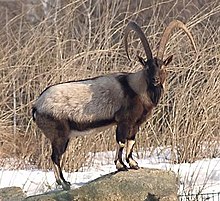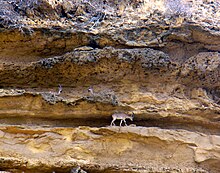Wild goat
| Wild goat Temporal range: Pleistocene - Recent
| |
|---|---|

| |
| Bezoar ibex, Capra aegagrus aegagrus | |
| Scientific classification | |
| Domain: | Eukaryota |
| Kingdom: | Animalia |
| Phylum: | Chordata |
| Class: | Mammalia |
| Order: | Artiodactyla |
| Family: | Bovidae |
| Subfamily: | Caprinae |
| Tribe: | Caprini
|
| Genus: | Capra |
| Species: | C. aegagrus
|
| Binomial name | |
| Capra aegagrus Erxleben, 1777
| |
| Subspecies | |
|
| |
The wild goat (Capra aegagrus) is a
It is thought to be the ancestor of the
Taxonomy
Capra aegagrus was the first
The following wild goat subspecies are considered valid taxa:[citation needed]
- Bezoar ibex C. a. aegagrus
- Sindh ibex C. a. blythi
- Chiltan ibex C. a. chialtanensis
- Turkmen wild goat C. a. turcmenica
The Cretan goat (formerly C. a. pictus), or kri-kri, was once thought to be a subspecies of wild goat, but is now considered to be a feral descendant of the domestic goat (Capra hircus), now known as Capra hircus cretica.
Distribution and habitat



In Turkey, the wild goat occurs in the Aegean, Mediterranean, Black Sea, Southeastern and the Eastern Anatolia Regions up to 4,500 m (14,800 ft) in the Taurus and Anti-Taurus Mountains.[citation needed]
In the Caucasus, it inhabits
In
Behaviour and ecology
In Kirthar National Park, 283 wild goat groups were observed for 10 months in 1986. The group sizes ranged from two to 131 individuals but varied seasonally, with a mean ratio of two females per male.[11]
In Dagestan, male wild goats start courting females in mid December. The rutting season lasts until the third week of January. Females give birth to between one and three kids in late June to mid July.[6]
Older males drive younger males from the maternal herds. The
Threats
Wild goat populations are threatened foremost by
See also
References
- ^ . Retrieved 9 February 2022.
- S2CID 24146711.
- ^ Erxleben, J. C. P. (1777). "Capra aegagrus". Systema regni animalis per classes, ordines, genera, species, varietates cvm synonymia et historia animalivm. Classis I. Mammalia. Lipsiae: Weygandt. pp. 520–521.
- ^ Hume, A. C. (1874). "Note on two apparently undescribed species of Goat from Northern India and a new species of Dove from the Nicobar Islands". Proceedings of the Asiatic Society of Bengal (December): 240–241.
- ^ Akhmedov, E. G.; Yarovenko, Y. A.; Nasrullaev, N. I.; Babaev, E. A.; Akhmedov, S. G. (2009). "Conservation of the Bezoar Goat in the Eastern Caucasus". In Zazanashvili, N.; Mallon, D. (eds.). Status and Protection of Globally Threatened Species in the Caucasus (PDF). Tbilisi: CEPF, WWF. pp. 26−31.
- ^ a b Weinberg, P. (2014). "On the status and biology of the wild goat in Daghestan (Russia)". Journal of Mountain Ecology. 6 (6): 31−40.
- ^ Khorozyan, I. G.; Weinberg, P. I.; Malkhasyan, A. G. (2009). "Conservation Strategy for Armenian Mouflon (Ovis [orientalis] gmelini Blyth) and Bezoar Goat (Capra aegagrus Erxleben) in Armenia". In Zazanashvili, N.; Mallon, D. (eds.). Status and Protection of Globally Threatened Species in the Caucasus (PDF). Tbilisi: CEPF, WWF. pp. 37−45.
- ^ Talibov, T. H.; Weinberg, P. I.; Mammadov, I. B.; Mammadov, E. N.; Talibov, S. T. (2009). "Conservation Strategy of the Asiatic Mouflon (Ovis [orientalis] gmelini Blyth) and the Bezoar Goat (Capra aegagrus Erxleben) in Azerbaijan". In Zazanashvili, N.; Mallon, D. (eds.). Status and Protection of Globally Threatened Species in the Caucasus (PDF). Tbilisi: CEPF, WWF. pp. 46−52.
- ]
- ^ Korshunov, V. M. (1994). "Ecology of the Bearded Goat (Capra aegagrus Erxleben 1777) in Turkmenistan". Biogeography and ecology of Turkmenistan. Monographiae Biologicae. Vol. 72. Dordrecht: Springer. pp. 231−246.
- ^ JSTOR 1382162.
External links
- "Capra aegagrus: Wild goat videos, photos and facts". Arkive. Archived from the original on 2017-06-12. Retrieved 2017-06-18.
- "Crete Wild Goat Capra aegagrus cretica". World Association of Zoos and Aquariums. Archived from the original on 2016-10-17. Retrieved 2017-06-18.

